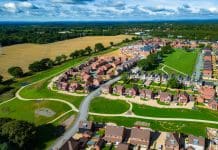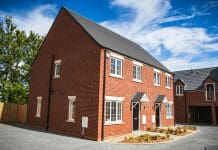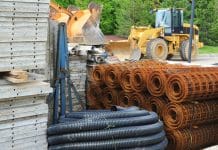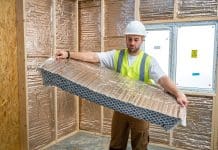Insights from the Belgian housing market, as analysed in the paper ‘The Cost of Sustainability in the Construction Sector – The Case of Family Houses in Belgium’ by Douhard & Van Pottelsberghe (2023), provide valuable lessons for the UK housebuilding industry
The UK housing sector plays a crucial role in economic growth and social well-being but is also a significant contributor to carbon emissions. As the government pushes for net-zero targets by 2050, sustainable construction practices are gaining momentum. This article examines the economic and environmental implications of sustainability in construction, comparing Belgium’s findings to the UK context.
Sustainability in housebuilding: A comparative overview
Belgium and the UK face similar challenges in housebuilding: high energy consumption, substantial greenhouse gas (GHG) emissions, and the need to balance affordability with sustainability.
In Belgium, the residential sector accounts for 14% of the total 106.8 Mt of CO₂ equivalent emissions (2020), primarily from space heating. The UK housing sector emits approximately 17% of total national CO₂ emissions, with an estimated 40% of emissions coming from operational energy use (heating, cooling, and electricity).
Both countries have a high proportion of detached and semi-detached houses, which demand more energy than apartments. The Belgian study highlights that 60-80% of a home’s carbon footprint comes from operational energy use, while 20-30% is embedded in construction materials and processes. This aligns with UK data showing that the operational phase is the most carbon-intensive period of a building’s life cycle.
Key findings from Belgium and their relevance to the UK
The embodied vs. operational carbon debate
The Belgian study conducted Life Cycle Assessments (LCA) and Life Cycle Costing (LCC) on two types of family homes:
- House 1 (detached, masonry structure)
- House 2 (semi-detached)
Each house had a more sustainable version using low-carbon materials like wood and cork instead of concrete and synthetic insulation.
Operational energy accounted for about 65% of total carbon impact in Belgian homes. Using sustainable materials reduced embodied carbon by up to 37% but had a negligible effect on operational energy use.
This insight is crucial for UK policymakers. The Future Homes Standard (FHS) mandates new UK homes to be “zero-carbon ready” from 2025, with high energy efficiency standards. However, the UK still lags in addressing embodied carbon, which is responsible for up to 25% of a building’s total emissions.
2. The cost of sustainability: A necessary trade-off?
One of the study’s key findings was the higher cost of sustainable housing construction:
- The total ownership cost (TOC) for sustainable homes was 7-11% higher than conventional homes in Belgium.
- The construction phase accounted for 67-69% of these costs, while operational costs (heating, maintenance) remained largely unchanged.
The UK already faces an affordable housing crisis, with developers reluctant to absorb higher costs. The current UK policy framework does not mandate carbon costing in housing projects, meaning developers have little incentive to use sustainable materials.
Potential UK policy solutions:
- Introduce carbon pricing in construction, rewarding low-carbon materials.
- Implement “green building grants” or tax incentives for sustainable construction.
- Require full life cycle carbon reporting for new developments.
3. Best sustainable practices: Windows, walls, and roofing
The study identified key construction elements where sustainable alternatives had the greatest carbon impact per pound spent:
- Windows (wood and cork frames): 3-6 kg CO₂ saved per € spent
- External walls (wooden structures instead of masonry): 6.2 kg CO₂ saved per € spent
- Roof insulation (cellulose and wool): significant savings but high upfront costs
In the UK, most sustainability efforts focus on insulation and heating efficiency (e.g., heat pumps), while materials are often overlooked. If UK housebuilders adopted carbon-optimised materials, it could substantially reduce embodied emissions without significant design changes.
Bridging the gap: How can the UK apply these lessons?
1. The role of policy
Belgium’s sustainability efforts are supported by national LCA databases (e.g., TOTEM), which assess materials’ carbon footprints. The UK lacks a comprehensive LCA framework for residential housing. Implementing a UK-wide database and certification system for low-carbon materials would help developers make informed choices.
2. Encouraging private sector adoption
While large developers (e.g., Barratt Developments, Taylor Wimpey) have started sustainability initiatives, smaller developers face cost barriers.
The UK government could:
- Provide low-interest green loans for sustainable construction.
- Offer fast-track planning approval for sustainable housing projects.
- Establish carbon credits for developers who meet high sustainability standards.
3. Enhancing consumer awareness
Belgium’s study found that homeowners underestimate the long-term financial savings of sustainable homes. In the UK, consumers focus on upfront costs rather than life-cycle savings. To shift this mindset:
- Introduce green mortgages, offering lower rates for energy-efficient homes.
- Require LCA disclosure on property listings, allowing buyers to compare sustainability impacts.
Future of UK housebuilding
The Belgian study provides compelling evidence that sustainable materials can significantly reduce a home’s carbon footprint—but at a higher initial cost. For the UK to achieve net-zero housing by 2050, it must address both operational and embodied carbon, incorporating:
- Stronger regulation on material sustainability.
- Financial incentives for green construction.
- Greater industry and consumer awareness.
By learning from Belgium’s experience, the UK can transition to more sustainable, cost-effective housing without compromising affordability.














